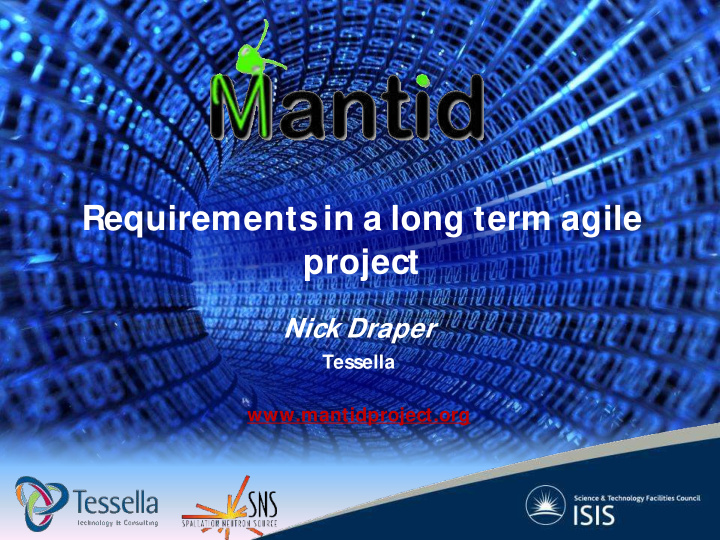



Requirements in a long term agile project Nick Draper Tessella www.mantidproject.org
Overview Requirements in Agile Projects Requirements throughout Mantid The problems Our solution
Key Principles of Agile projects Active user involvement is imperative Requirements evolve but the timescale is fixed Capture requirements at a high level; lightweight & visual Develop small, incremental releases and iterate Focus on frequent delivery of products Apply the 80/20 rule Testing is integrated throughout the project lifecycle test early and often
Key Principles of Agile projects Active user involvement is imperative Requirements evolve but the timescale is fixed Capture requirements at a high level; lightweight & visual Develop small, incremental releases and iterate Focus on frequent delivery of products Apply the 80/20 rule Testing is integrated throughout the project lifecycle test early and often
Key Principles of Agile projects Active user involvement is imperative Requirements evolve but the timescale is fixed Capture requirements at a high level; lightweight & visual Develop small, incremental releases and iterate Focus on frequent delivery of products Apply the 80/20 rule Testing is integrated throughout the project lifecycle test early and often
Project Goals Goals Consolidate the data reduction/analysis software for neutron scattering without restricting the needs of the instrument scientists Key requirement Create a Data Analysis framework not instrument or technique/dependent Cross-platform Windows, Linux, Mac Easily extensible Open source
Mantid in the beginning Requirements User Requirements System meetings Document Requirements Architectural Document Design Document Gaudi In-house Tool Selection Prototyping & evaluation
Mantid in the beginning Good Bad Tough to separate vital detail Wide cross section of from the rest scientists Requirements Stakeholder coverage Separated high level from details Built relationships Documented and agreed requirements Learning from other projects Accuracy vs. time Prototyping Evaluation of current Bias software Gathering best practice
Mantid early development 1 month iterations Development High risk design features Plug in architecture Python Integration Vital common data structures Evaluated by: Workspace2D • Lead Scientist • Workspace History Project Manager • Instrument Geometry Project Team Common algorithms LoadRaw Rebin ConvertUnits Unit testing, continuous integration from the start
Mantid early development Good Bad No wider stakeholder Rapid development engagement De-risking design decisions Little immediate use Validation of framework Low visibility to senior approach management Gathered momentum within the team
Improving Stakeholder engagement Scientific Steering Users Committee Scientific Steering 1 -> 3 month releases Committee Better fit with cycle timings Development Team User Training Release Notes Project Management Board
Expanding the project ISIS SNS/HIFR Scientific Steering Users Users Committee Scientific Steering Scientific Steering Every 3 months Committee Committee Local scientific steering Development Development committees Team Team Joint teleconferences every 6 Project Management months Board Two way information flow Project progress -> scientsts Requirements & priorities -> dev team
Problems The two facilities were in two very different situations ISIS had been involved since the start, and were looking to extend capability. SNS were finding how to fit Mantid to their needs Information did not flow reliably beyond members Progress Requirements & Priorities How to handle strategic and longer term tasks? Requirements Process Visibility
Annual Joint Scientific Steering Committee Extract longer term requirements Ask less often! Place greater importance on the event Spend time, listening and feeding back Deliver on your promises Encourage wider collaboration Face to face meetings lead to much more agreement The joint meeting allow time for other conversations with remote colleagues
Release Presentations Just before each release Everyone invited But participation optional Development team present progress Different focus topic each time Covers complete functionality in that area, not just improvements Meet the team at the end Opportunity to chat to the scientists and solve any problems.
Conclusion A good overview at the start of an Agile project is essential Requirements gathering approaches need to change during a long term project Do not assume that others will pass the message of the good work you are doing onwards One collaborative project is a great opportunity to found others
Recommend
More recommend